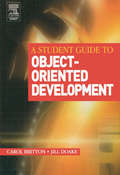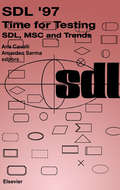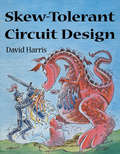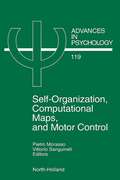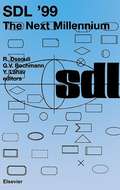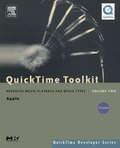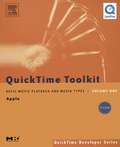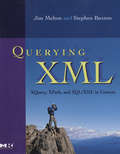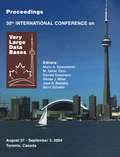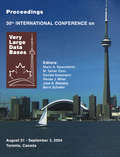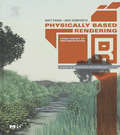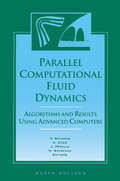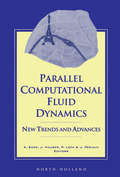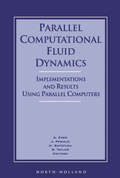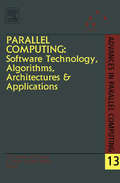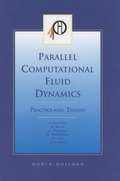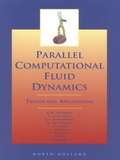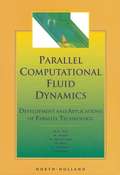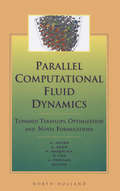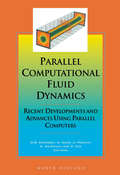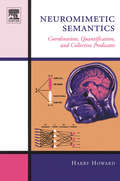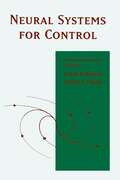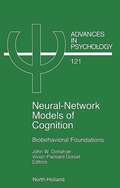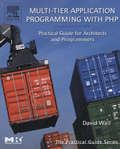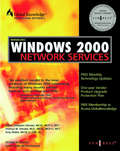- Table View
- List View
A Student Guide to Object-Oriented Development
by Carol Britton Jill DoakeA Student Guide to Object-Oriented Development is an introductory text that follows the software development process, from requirements capture to implementation, using an object-oriented approach. The book uses object-oriented techniques to present a practical viewpoint on developing software, providing the reader with a basic understanding of object-oriented concepts by developing the subject in an uncomplicated and easy-to-follow manner. It is based on a main worked case study for teaching purposes, plus others with password-protected answers on the web for use in coursework or exams. Readers can benefit from the authors' years of teaching experience. The book outlines standard object-oriented modelling techniques and illustrates them with a variety of examples and exercises, using UML as the modelling language and Java as the language of implementation. It adopts a simple, step by step approach to object-oriented development, and includes case studies, examples, and exercises with solutions to consolidate learning. There are 13 chapters covering a variety of topics such as sequence and collaboration diagrams; state diagrams; activity diagrams; and implementation diagrams. This book is an ideal reference for students taking undergraduate introductory/intermediate computing and information systems courses, as well as business studies courses and conversion masters' programmes.Adopts a simple, step by step approach to object-oriented developmentIncludes case studies, examples, and exercises with solutions to consolidate learningBenefit from the authors' years of teaching experience
SDL '97: SDL, MSC and Trends
by Ana Cavalli Amardeo SarmaAs Cavalli and Sarma astutely remarked in the introduction to this volume, it is quite remarkable that SDL '97 may have the first participant younger than SDL itself. SDL '97 provides the opportunity to reflect the course SDL has taken and why it has been successful over two decades where other languages addressing the same market have failed.SDL now also has a permanent companion in MSC (Message Sequence Charts). MSC today is a language in its own right and has its areas of application both in conjunction with SDL and independently or in combination with other techniques. MSC has strong structuring concepts to specify message sequences for large systems and can be used to develop scenarios, which is extremely useful for test and design environments. The SDL Forum today really is the SDL and MSC Forum.
Skew-Tolerant Circuit Design (ISSN)
by David HarrisAs advances in technology and circuit design boost operating frequencies of microprocessors, DSPs and other fast chips, new design challenges continue to emerge. One of the major performance limitations in today's chip designs is clock skew, the uncertainty in arrival times between a pair of clocks. Increasing clock frequencies are forcing many engineers to rethink their timing budgets and to use skew-tolerant circuit techniques for both domino and static circuits. While senior designers have long developed their own techniques for reducing the sequencing overhead of domino circuits, this knowledge has routinely been protected as trade secret and has rarely been shared. Skew-Tolerant Circuit Design presents a systematic way of achieving the same goal and puts it in the hands of all designers. This book clearly presents skew-tolerant techniques and shows how they address the challenges of clocking, latching, and clock skew. It provides the practicing circuit designer with a clearly detailed tutorial and an insightful summary of the most recent literature on these critical clock skew issues.Synthesizes the most recent advances in skew-tolerant design in one cohesive tutorialProvides incisive instruction and advice punctuated by humorous illustrationsIncludes exercises to test understanding of key concepts and solutions to selected exercises
Self-Organization, Computational Maps, and Motor Control (ISSN #Volume 119)
by P.G. Morasso V. SanguinetiIn the study of the computational structure of biological/robotic sensorimotor systems, distributed models have gained center stage in recent years, with a range of issues including self-organization, non-linear dynamics, field computing etc. This multidisciplinary research area is addressed here by a multidisciplinary team of contributors, who provide a balanced set of articulated presentations which include reviews, computational models, simulation studies, psychophysical, and neurophysiological experiments.The book is divided into three parts, each characterized by a slightly different focus: in part I, the major theme concerns computational maps which typically model cortical areas, according to a view of the sensorimotor cortex as "geometric engine" and the site of "internal models" of external spaces. Part II also addresses problems of self-organization and field computing, but in a simpler computational architecture which, although lacking a specialized cortical machinery, can still behave in a very adaptive and surprising way by exploiting the interaction with the real world. Finally part III is focused on the motor control issues related to the physical properties of muscular actuators and the dynamic interactions with the world.The reader will find different approaches on controversial issues, such as the role and nature of force fields, the need for internal representations, the nature of invariant commands, the vexing question about coordinate transformations, the distinction between hierachiacal and bi-directional modelling, and the influence of muscle stiffness.
SDL '99: The Next Millennium
by R. Dssouli G. V. Bochmann Y. LahavThis book represents the proceedings of the 9th SDL Forum which was held in Montreal, Quebec, Canada, during the week of June 21-25, 1999. The 9th SDL Forum presents papers on the past and future development of the MSC and SDL languages.The volume presents information on experience with the use of these languages in industrial development projects, on tools and techniques for using these languages in the software and hardware development process, and other aspects of these languages.
QuickTime Toolkit Volume Two: Advanced Movie Playback and Media Types (QuickTime Developer Series)
by Tim Monroe"Buried inside QuickTime are a host of powerful tools for creating, delivering, and playing digital media. The official QuickTime documentation explains 'what' each API function does. But knowing what each function does isn't enough to allow a developer to take full advantage of QuickTime. QuickTime Toolkit fills in the gap—providing plenty of practical examples of 'how' to use QuickTime to perform all kinds of useful tasks. More importantly, [this book] goes beyond 'how' and into 'why' —providing readers with a deeper understanding of QuickTime and how to benefit from using it in their own products." —Peter Hoddie, cofounder of Kinoma and former QuickTime architectQuickTime Toolkit, Volume Two continues the step-by-step investigation of programming QuickTime, the elegant and powerful media engine used by many of Apple's industry-leading services and products (such as the iTunes music store, iMovie, and Final Cut Pro) and also used by a large number of third-party applications. This second collection of articles from the author's highly regarded column in MacTech Magazine builds upon the discussion of playback techniques and media types presented in the first volume to cover advanced types of QuickTime media data, including video effects, Flash tracks, and skins. It shows how to capture audio and video data, broadcast that data to remote computers, play movies full screen, and load movies asynchronously. QuickTime Toolkit Volume Two also shows how to integrate Carbon events into your Macintosh application and how to work with Macintosh resources in your Windows application.Part of the official QuickTime Developer Series, publishing the finest books on QuickTime in cooperation with Apple.Written by one of Apple's premier media engineers skilled in revealing QuickTime's sophisticated technology to programmersOffers many undocumented insider tips for making applications that work well in both Mac OS and Windows
QuickTime Toolkit Volume One: Basic Movie Playback and Media Types (QuickTime Developer Series)
by Tim Monroe"When QuickTime application developers get stuck, one of the first places they look for help is example code from Tim Monroe. Finally, Tim's well-crafted examples and clear descriptions are available in book form—a must-have for anyone writing applications that import, export, display, or interact with QuickTime movies." —Matthew Peterson; University of California, Berkeley; the M.I.N.D. Institute; and author of Interactive QuickTimeQuickTime Toolkit Volume One is a programmer’s introduction to QuickTime, the elegant and potent media engine used by many of Apple's industry-leading services and products (such as the iTunes music store, iMovie, and Final Cut Pro) and also used by a large number of third-party applications. This hands-on guide shows you how to harness the powerful capabilities of QuickTime for your own projects. The articles collected here from the author's highly regarded column in MacTech Magazine are packed with accessible code examples to get you quickly started developing applications that can display and create state-of-the-art digital content. This book begins by showing how to open and display QuickTime movies in a Macintosh or Windows application and progresses step by step to show you how to control movie playback and how to import and transform movies and images. QuickTime Toolkit also shows how to create movies with video data, text, time codes, sprites, and wired (interactive) elements.Part of the official QuickTime Developer Series, publishing the finest books on QuickTime in cooperation with Apple.Written in a clear, engaging style by one of Apple's premier media engineers known for his ability to make QuickTime's sophisticated technology accessible to software developersOffers many undocumented insider tips for making applications that work well in both Mac OS and Windows
Querying XML: XQuery, XPath, and SQL/XML in context (The Morgan Kaufmann Series in Data Management Systems)
by Jim Melton Stephen BuxtonXML has become the lingua franca for representing business data, for exchanging information between business partners and applications, and for adding structure–and sometimes meaning—to text-based documents. XML offers some special challenges and opportunities in the area of search: querying XML can produce very precise, fine-grained results, if you know how to express and execute those queries.For software developers and systems architects: this book teaches the most useful approaches to querying XML documents and repositories. This book will also help managers and project leaders grasp how “querying XML" fits into the larger context of querying and XML. Querying XML provides a comprehensive background from fundamental concepts (What is XML?) to data models (the Infoset, PSVI, XQuery Data Model), to APIs (querying XML from SQL or Java) and more.* Presents the concepts clearly, and demonstrates them with illustrations and examples; offers a thorough mastery of the subject area in a single book. * Provides comprehensive coverage of XML query languages, and the concepts needed to understand them completely (such as the XQuery Data Model).* Shows how to query XML documents and data using: XPath (the XML Path Language); XQuery, soon to be the new W3C Recommendation for querying XML; XQuery's companion XQueryX; and SQL, featuring the SQL/XML * Includes an extensive set of XQuery, XPath, SQL, Java, and other examples, with links to downloadable code and data samples.
Proceedings 2004 VLDB Conference: The 30th International Conference on Very Large Databases (VLDB)
by VLDBProceedings of the 30th Annual International Conference on Very Large Data Bases held in Toronto, Canada on August 31 - September 3 2004. Organized by the VLDB Endowment, VLDB is the premier international conference on database technology.
Proceedings 2003 VLDB Conference: 29th International Conference on Very Large Databases (VLDB)
by VLDBProceedings of the 29th Annual International Conference on Very Large Data Bases held in Berlin, Germany on September 9-12, 2003. Organized by the VLDB Endowment, VLDB is the premier international conference on database technology.
Physically Based Rendering: From Theory to Implementation
by Matt Pharr Greg HumphreysRendering is a crucial component of computer graphics— the conversion of a description of a 3D scene into an image for display. Algorithms for animation, geometric modeling, and texturing all must feed their results through some sort of rendering process for the results to be visible in an image. Focusing on realistic images, physically based rendering incorporates ideas from a range of disciplines, including physics, biology, psychology, cognitive science, and mathematics. This book presents the algorithms of modern photorealistic rendering and follows step by step the creation of a complete rendering system. As each new rendering concept is introduced it is also shown implemented in code—there is no better way to understand the subtle and complex process of rendering. The code itself is highly readable, written in the literate programming style that mixes text describing the system with the code that implements it. The result is a stunning achievement in graphics education for students, professionals, and researchers.*CD-ROM with the source code for a complete rendering system for Windows, OS X, & Linux—with many examples of images created by the system throughout the 4 color text*The code and text are tightly woven together through the technique of literate programming with a unique indexing feature that lists all locations of functions, variables, and methods on the page they are first described*The most complete guide to understanding, designing, and building a rendering system
Parallel Computational Fluid Dynamics '96: Algorithms and Results Using Advanced Computers
by P. Schiano N. Satofuka A. Ecer Jacques PeriauxIn the last decade parallel computing has been put forward as the only computational answer to the increasing computational needs arising from very large and complex fluid dynamic problems. Considerable efforts are being made to use parallel computers efficiently to solve several fluid dynamic problems originating in aerospace, climate modelling and environmental applications.Parallel CFD Conferences are international and aim to increase discussion among researchers worldwide.Topics covered in this particular book include typical CFD areas such as turbulence, Navier-Stokes and Euler solvers, reactive flows, with a good balance between both university and industrial applications. In addition, other applications making extensive use of CFD such as climate modelling and environmental applications are also included.Anyone involved in the challenging field of Parallel Computational Fluid Dynamics will find this volume useful in their daily work.
Parallel Computational Fluid Dynamics '93: New Trends and Advances
by P. Leca A. Ecer Jacques Periaux J. HauserThis volume contains the papers presented at the Parallel Computing Fluid Dynamics '93 Conference, Paris, 1993. A wide range of topics are covered including: networked computers, data parallel programming, domain decomposition, Euler and Navier-Stokes solvers.Researchers in this area will find this volume a useful reference in this rapidly developing field.
Parallel Computational Fluid Dynamics '95: Implementations and Results Using Parallel Computers
by A. Ecer N. Satofuka Jacques Periaux S. TaylorParallel Computational Fluid Dynamics(CFD) is an internationally recognised fast-growing field. Since 1989, the number of participants attending Parallel CFD Conferences has doubled.In order to keep track of current global developments, the Parallel CFD Conference annually brings scientists together to discuss and report results on the utilization of parallel computing as a practical computational tool for solving complex fluid dynamic problems. This volume contains the results of research conducted during the past year.Subject areas covered include: novel parallel algorithms, parallel Euler and Navier-Stokes solvers, parallel Direct Simulation Monte Carlo method and parallel multigrid techniques. The content of the book also demonstrates that considerable effort is being made to utilize parallel computing to solve a variety of fluid dynamics problems in topics such as climate modeling, consultation, aerodynamics and in many other areas.Readers of this book will gain a valid insight into the exciting recent developments in Parallel CFD research.
Parallel Computing: Proceedings of the International Conference ParCo2003, Dresden, Germany (ISSN #Volume 13)
by Gerhard Joubert Wolfgang Nagel Frans Peters Wolfgang WalterAdvances in Parallel Computing series presents the theory and use of of parallel computer systems, including vector, pipeline, array, fifth and future generation computers and neural computers. This volume features original research work, as well as accounts on practical experience with and techniques for the use of parallel computers.
Parallel Computational Fluid Dynamics 2001, Practice and Theory
by Jacques Periaux P. Wilders P. Fox A. Ecer N. SatofukaParCFD 2001, the thirteenth international conference on Parallel Computational Fluid Dynamics took place in Egmond aan Zee, the Netherlands, from May 21-23, 2001. The specialized, high-level ParCFD conferences are organized yearly on traveling locations all over the world. A strong back-up is given by the central organization located in the USA http://www.parcfd.org. These proceedings of ParCFD 2001 represent 70% of the oral lectures presented at the meeting. All published papers were subjected to a refereeing process, which resulted in a uniformly high quality. The papers cover not only the traditional areas of the ParCFD conferences, e.g. numerical schemes and algorithms, tools and environments, interdisciplinary topics, industrial applications, but, following local interests, also environmental and medical issues. These proceedings present an up-to-date overview of the state of the art in parallel computational fluid dynamics.
Parallel Computational Fluid Dynamics 2000: Trends and Applications
by Jacques Periaux P. Fox A. Ecer N. Satofuka C.B. Jenssen T. Kvamdal H.I. Andersson B. PettersenParallel CFD 2000, the Twelfth in an International series of meetings featuring computational fluid dynamics research on parallel computers, was held May 22-25, 2000 in Trondheim, Norway. Following the trend of the past conferences, areas such as numerical schemes and algorithms, tools and environments, load balancing, as well as interdisciplinary topics and various kinds of industrial applications were all well represented in the work presented. In addition, for the first time in the Parallel CFD conference series, the organizing committee chose to draw special attention to certain subject areas by organizing a number of special sessions. We feel the emphasis of the papers presented at the conference reflect the direction of the research within parallel CFD at the beginning of the new millennium. It seems to be a clear tendency towards increased industrial exploitation of parallel CFD. Several presentations also demonstrated how new insight is being achieved from complex simulations, and how powerful parallel computers now make it possible to use CFD within a broader interdisciplinary setting. Obviously, successful application of parallel CFD still rests on the underlying fundamental principles. Therefore, numerical algorithms, development tools, and parallelization techniques are still as important as when parallel CFD was in is infancy. Furthermore, the novel concepts of affordable parallel computing as well as metacomputing show that exciting developments are still taking place. As is often pointed out however, the real power of parallel CFD comes from the combination of all the disciplines involved: Physics, mathematics, and computer science. This is probably one of the principal reasons for the continued popularity of the Parallel CFD Conferences series, as well as the inspiration behind much of the excellent work carried out on the subject. We hope that the papers in this book, both on an individual basis and as a whole, will contribute to that inspiration. Further details of Parallel CFD'99, as well as other conferences in this series, are available at http://www.parcfd.org
Parallel Computational Fluid Dynamics '98: Development and Applications of Parallel Technology
by Jacques Periaux P. Fox A. Ecer N. Satofuka Chiao-Ling LinThis book contains the papers presented at the Parallel Computational Fluid Dynamics 1998 Conference. The book is focused on new developments and applications of parallel technology. Key topics are introduced through contributed papers and invited lectures. These include typical algorithmic developments, such as: distributed computing, domain decomposition and parallel algorithm. Some of the papers address the evaluations of software and machine performance and software tool environments. The application of parallel computers to complex fluid dynamics problems are also conveyed through sessions such as DNS/LES, combustion and reacting flows, industrial applications, water resources and environmental flows.The editors believe this book will provide many researchers, much beyond those contributing to this volume, with fresh information and reference.
Parallel Computational Fluid Dynamics '99: Towards Teraflops, Optimization and Novel Formulations
by Jacques Periaux P. Fox A. Ecer N. Satofuka D. KeyesContributed presentations were given by over 50 researchers representing the state of parallel CFD art and architecture from Asia, Europe, and North America. Major developments at the 1999 meeting were: (1) the effective use of as many as 2048 processors in implicit computations in CFD, (2) the acceptance that parallelism is now the 'easy part' of large-scale CFD compared to the difficulty of getting good per-node performance on the latest fast-clocked commodity processors with cache-based memory systems, (3) favorable prospects for Lattice-Boltzmann computations in CFD (especially for problems that Eulerian and even Lagrangian techniques do not handle well, such as two-phase flows and flows with exceedingly multiple-connected demains with a lot of holes in them, but even for conventional flows already handled well with the continuum-based approaches of PDEs), and (4) the nascent integration of optimization and very large-scale CFD. Further details of Parallel CFD'99, as well as other conferences in this series, are available at http://www.parcfd.org
Parallel Computational Fluid Dynamics '97: Recent Developments and Advances Using Parallel Computers
by A. Ecer Jacques Periaux D. Emerson P. Fox N. SatofukaComputational Fluid Dynamics (CFD) is a discipline that has always been in the vanguard of the exploitation of emerging and developing technologies. Advances in both algorithms and computers have rapidly been absorbed by the CFD community in its quest for more accurate simulations and reductions in the time to solution. Within this context, parallel computing has played an increasingly important role. Moreover, the uptake of parallel computing has brought the CFD community into ever-closer contact with hardware vendors and computer scientists. The multidisciplinary subject of parallel CFD and its rapidly evolving nature, in terms of hardware and software, requires a regular international meeting of this nature to keep abreast of the most recent developments.Parallel CFD '97 is part of an annual conference series dedicated to the discussion of recent developments and applications of parallel computing in the field of CFD and related disciplines. This was the 9th in the series, and since the inaugural conference in 1989, many new developments and technologies have emerged. The intervening years have also proved to be extremely volatile for many hardware vendors and a number of companies appeared and then disappeared. However, the belief that parallel computing is the only way forward has remained undiminished. Moreover, the increasing reliability and acceptance of parallel computers has seen many commercial companies now offering parallel versions of their codes, many developed within the EC funded EUROPORT activity, but generally for more modest numbers of processors. It is clear that industry has not moved to large scale parallel systems but it has shown a keen interest in more modest parallel systems recognising that parallel computing will play an important role in the future. This book forms the proceedings of the CFD '97 conference, which was organised by the the Computational Engineering Group at Daresbury Laboratory and held in Manchester, England, on May 19-21 1997. The sessions involved papers on many diverse subjects including turbulence, reactive flows, adaptive schemes, unsteady flows, unstructured mesh applications, industrial applications, developments in software tools and environments, climate modelling, parallel algorithms, evaluation of computer architectures and a special session devoted to parallel CFD at the AEREA research centres. This year's conference, like its predecessors, saw a continued improvement in both the quantity and quality of contributed papers.Since the conference series began many significant milestones have been acheived. For example in 1994, Massively Parallel Processing (MPP) became a reality with the advent of Cray T3D. This, of course, has brought with it the new challenge of scalability for both algorithms and architectures. In the 12 months since the 1996 conference, two more major milestones were achieved: microprocessors with a peak performance of a Gflop/s became available and the world's first Tflop/s calculation was performed. In the 1991 proceedings, the editors indicated that a Tflop/s computer was likely to be available in the latter half of this decade. On December 4th 1996, Intel achieved this breakthrough on the Linpack benchmark using 7,264 (200MHz) Pentium Pro microprocessors as part of the ASCI Red project. With the developments in MPP, the rapid rise of SMP architectures and advances in PC technology, the future for parallel CFD looks both promising and challenging.
Neuromimetic Semantics: Coordination, quantification, and collective predicates
by Harry HowardThis book attempts to marry truth-conditional semantics with cognitive linguistics in the church of computational neuroscience. To this end, it examines the truth-conditional meanings of coordinators, quantifiers, and collective predicates as neurophysiological phenomena that are amenable to a neurocomputational analysis. Drawing inspiration from work on visual processing, and especially the simple/complex cell distinction in early vision (V1), we claim that a similar two-layer architecture is sufficient to learn the truth-conditional meanings of the logical coordinators and logical quantifiers. As a prerequisite, much discussion is given over to what a neurologically plausible representation of the meanings of these items would look like. We eventually settle on a representation in terms of correlation, so that, for instance, the semantic input to the universal operators (e.g. and, all)is represented as maximally correlated, while the semantic input to the universal negative operators (e.g. nor, no)is represented as maximally anticorrelated. On the basis this representation, the hypothesis can be offered that the function of the logical operators is to extract an invariant feature from natural situations, that of degree of correlation between parts of the situation. This result sets up an elegant formal analogy to recent models of visual processing, which argue that the function of early vision is to reduce the redundancy inherent in natural images. Computational simulations are designed in which the logical operators are learned by associating their phonological form with some degree of correlation in the inputs, so that the overall function of the system is as a simple kind of pattern recognition. Several learning rules are assayed, especially those of the Hebbian sort, which are the ones with the most neurological support. Learning vector quantization (LVQ) is shown to be a perspicuous and efficient means of learning the patterns that are of interest. We draw a formal parallelism between the initial, competitive layer of LVQ and the simple cell layer in V1, and between the final, linear layer of LVQ and the complex cell layer in V1, in that the initial layers are both selective, while the final layers both generalize. It is also shown how the representations argued for can be used to draw the traditionally-recognized inferences arising from coordination and quantification, and why the inference of subalternacy breaks down for collective predicates. Finally, the analogies between early vision and the logical operators allow us to advance the claim of cognitive linguistics that language is not processed by proprietary algorithms, but rather by algorithms that are general to the entire brain. Thus in the debate between objectivist and experiential metaphysics, this book falls squarely into the camp of the latter. Yet it does so by means of a rigorous formal, mathematical, and neurological exposition – in contradiction of the experiential claim that formal analysis has no place in the understanding of cognition. To make our own counter-claim as explicit as possible, we present a sketch of the LVQ structure in terms of mereotopology, in which the initial layer of the network performs topological operations, while the final layer performs mereological operations.
Neural Systems for Control
by Omid Omidvar David L. ElliottControl problems offer an industrially important application and a guide to understanding control systems for those working in Neural Networks. Neural Systems for Control represents the most up-to-date developments in the rapidly growing aplication area of neural networks and focuses on research in natural and artifical neural systems directly applicable to control or making use of modern control theory. The book covers such important new developments in control systems such as intelligent sensors in semiconductor wafer manufacturing; the relation between muscles and cerebral neurons in speech recognition; online compensation of reconfigurable control for spacecraft aircraft and other systems; applications to rolling mills, robotics and process control; the usage of past output data to identify nonlinear systems by neural networks; neural approximate optimal control; model-free nonlinear control; and neural control based on a regulation of physiological investigation/blood pressure control. All researchers and students dealing with control systems will find the fascinating Neural Systems for Control of immense interest and assistance.Focuses on research in natural and artifical neural systems directly applicable to contol or making use of modern control theoryRepresents the most up-to-date developments in this rapidly growing application area of neural networksTakes a new and novel approach to system identification and synthesis
Neural Network Models of Cognition: Biobehavioral Foundations (ISSN #Volume 121)
by J. W. Donahoe V. P. DorselThis internationally authored volume presents major findings, concepts, and methods of behavioral neuroscience coordinated with their simulation via neural networks. A central theme is that biobehaviorally constrained simulations provide a rigorous means to explore the implications of relatively simple processes for the understanding of cognition (complex behavior). Neural networks are held to serve the same function for behavioral neuroscience as population genetics for evolutionary science. The volume is divided into six sections, each of which includes both experimental and simulation research: (1) neurodevelopment and genetic algorithms, (2) synaptic plasticity (LTP), (3) sensory/hippocampal systems, (4) motor systems, (5) plasticity in large neural systems (reinforcement learning), and (6) neural imaging and language. The volume also includes an integrated reference section and a comprehensive index.
Multi-Tier Application Programming with PHP: Practical Guide for Architects and Programmers (The Practical Guides)
by David WallWhile many architects use PHP for projects, they are often not aware of the power of PHP in creating enterprise-level applications. This book covers the latest version of PHP – version 5 -- and focuses on its capabilities within a multi-tier application framework. It contains numerous coding samples and commentaries on them. A chapter discusses object orientation in PHP as it applies to the multi-tier architecture and other chapters discuss HTTP and SOAP, the two communication protocols most useful in tying together multiple layers. There is also coverage of database design and query construction as well as information about tricks you can use in generating user interfaces.Covers PHP as it relates to developing software in a multi-tier environment—a crucial aspect of developing robust software with low cost and ease of use as design goals. Makes extensive use of Simple Object Access Protocol (SOAP) and Web Services as implemented in PHP and NuSOAP.Shows precisely how to make use of the InnoDB table type newly available in MySQL. InnoDB supports true referential integrity and row-level locking.An application example (a multi-currency bookkeeping application) runs throughout the book, showing various PHP capabilities as well as the database interaction.
Managing Windows 2000 Network Services
by SyngressMany organizations and network administrators are looking for information on Windows 2000 and its new features. IT professionals responsible for installing, configuring and managing Microsoft products will be highly motivated to migrate to this new technology, based on its promise of reducing administrative overhead.Microsoft Windows 2000 Server (the predecessor to Windows NT 4 Server) integrates network services for companies and administrators to set up and manage networks, remote access and extranets, as well as to manage other communications. Managing Windows 2000 Network Services will be the first book to focus exclusively on networking and integrated voice, video, and data on networks. Readers will learn how to deploy and integrate all Windows 2000 networking technologies within an enterprise network.* The publication of the book will be with or soon after the release of Windows 2000* Focuses completely on Network Services
